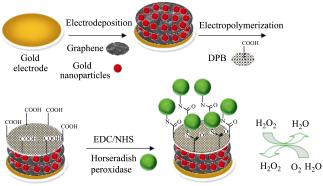1 Li, X. S.; Cai, W. W.; An, J. H.; Kim, S. Y.; Nah, J.; Yang, D. G.; Piner, R.; Velamakanni, A.; Jung, I.; Tutuc, E.; Banerjee, S. K.; Colombo, L.; Ruff, R. S. Science 2009,324, 1312.  2 Elias, D. C.; Nair, R. R.; Mohiuddin, T. M. G.; Morozov, S. V.; Blake, P.; Halsall, M. P.; Ferrari, A. C.; Boukhvalov, D. W.; Katsnelson, M. I.; Geim, A. K.; Novoselov, K. S. Science2009, 323, 610. 2 Elias, D. C.; Nair, R. R.; Mohiuddin, T. M. G.; Morozov, S. V.; Blake, P.; Halsall, M. P.; Ferrari, A. C.; Boukhvalov, D. W.; Katsnelson, M. I.; Geim, A. K.; Novoselov, K. S. Science2009, 323, 610.  3 Yan, X.; Cui, X.; Li, L. S. J. Am. Chem. Soc. 2010, 132,5944. 3 Yan, X.; Cui, X.; Li, L. S. J. Am. Chem. Soc. 2010, 132,5944.  4 Xu, C.; Wang, X.; Zhu, J. W. J. Phys. Chem. C 2008, 112,19841. 4 Xu, C.; Wang, X.; Zhu, J. W. J. Phys. Chem. C 2008, 112,19841.  5 Zhong, Z. Y.; Wu, W.; Wang, D.; Wang, D.; Shan, J. L.; Qing, Y.; Zhang, Z. M. Biosens. Bioelectron. 2010, 25,2379. 5 Zhong, Z. Y.; Wu, W.; Wang, D.; Wang, D.; Shan, J. L.; Qing, Y.; Zhang, Z. M. Biosens. Bioelectron. 2010, 25,2379.  6 Hong, W. J.; Bai, H.; Xu, Y. X.; Yao, Z. Y.; Gu, Z. Z.; Shi, G. Q. J. Phys. Chem. C 2010, 114, 1822. 6 Hong, W. J.; Bai, H.; Xu, Y. X.; Yao, Z. Y.; Gu, Z. Z.; Shi, G. Q. J. Phys. Chem. C 2010, 114, 1822.  7 Wan, Y.; Wang, Y.; Wu, J. J.; Zhang, D. Anal. Chem. 2011,83, 648. 7 Wan, Y.; Wang, Y.; Wu, J. J.; Zhang, D. Anal. Chem. 2011,83, 648.  8 Gu, Z. G.; Yang, S. P.; Li, Z. J.; Sun, X. L.; Wang, G. L.; Fang, Y. J.; Liu, J. K. Electrochim. Acta 2011, 56, 9162. 8 Gu, Z. G.; Yang, S. P.; Li, Z. J.; Sun, X. L.; Wang, G. L.; Fang, Y. J.; Liu, J. K. Electrochim. Acta 2011, 56, 9162.  9 Gu, Z. G.; Yang, S. P.; Li, Z. J.; Sun, X. L.; Wang, G. L.; Fang, Y. J.; Liu, J. K. Anal. Chim. Acta 2011, 701, 75. 9 Gu, Z. G.; Yang, S. P.; Li, Z. J.; Sun, X. L.; Wang, G. L.; Fang, Y. J.; Liu, J. K. Anal. Chim. Acta 2011, 701, 75.  10 Wen, Z. L.; Yang, S. D.; Song, Q. J.; Hao, L.; Zhang, X. G. Acta Phys.-Chim. Sin. 2010, 26, 1570 (in Chinese). (温祝亮, 杨苏东, 宋启军, 郝亮, 张校刚, 物理化学学 报, 2010, 26, 1570.)11 Liu, C. B.; Wang, K.; Luo, S. L.; Tang, Y. H.; Chen, L. Y. Small 2011, 7, 1203. 10 Wen, Z. L.; Yang, S. D.; Song, Q. J.; Hao, L.; Zhang, X. G. Acta Phys.-Chim. Sin. 2010, 26, 1570 (in Chinese). (温祝亮, 杨苏东, 宋启军, 郝亮, 张校刚, 物理化学学 报, 2010, 26, 1570.)11 Liu, C. B.; Wang, K.; Luo, S. L.; Tang, Y. H.; Chen, L. Y. Small 2011, 7, 1203.  12 Chen, X. M.; Wu, G. H.; Chen, J. M.; Chen, X.; Xie, Z. X.; Wang, X. R. J. Am. Chem. Soc. 2011, 133, 3693. 12 Chen, X. M.; Wu, G. H.; Chen, J. M.; Chen, X.; Xie, Z. X.; Wang, X. R. J. Am. Chem. Soc. 2011, 133, 3693.  13 Yang, Y. C.; Dong, S. W.; Shen, T.; Jian, C. X.; Chang, H. J.; Li, Y.; Zhou, J. X. Electrochim. Acta 2011, 56, 6021. 13 Yang, Y. C.; Dong, S. W.; Shen, T.; Jian, C. X.; Chang, H. J.; Li, Y.; Zhou, J. X. Electrochim. Acta 2011, 56, 6021.  14 Yang, M. H.; Li, C. X.; Yang, Y. H.; Shen, G. L.; Yu, R. Q. Acta Chim. Sinica 2004, 62, 502 (in Chinese). (阳明辉, 李春香, 杨云慧, 沈国励, 俞汝勤, 化学学报,2004, 62, 502.)15 Zhu, L. S.; Ai, S. Y.; Yin, H. S.; Zhang, Q. M.; Zhou, Y. L.; Ma, Q.; Liu, T. Electrochim. Acta 2011, 56, 2748. 14 Yang, M. H.; Li, C. X.; Yang, Y. H.; Shen, G. L.; Yu, R. Q. Acta Chim. Sinica 2004, 62, 502 (in Chinese). (阳明辉, 李春香, 杨云慧, 沈国励, 俞汝勤, 化学学报,2004, 62, 502.)15 Zhu, L. S.; Ai, S. Y.; Yin, H. S.; Zhang, Q. M.; Zhou, Y. L.; Ma, Q.; Liu, T. Electrochim. Acta 2011, 56, 2748.  16 Bo, Y.; Wang, W.; Qi, J.; Huang, S. Analyst 2011, 136, 1946. 16 Bo, Y.; Wang, W.; Qi, J.; Huang, S. Analyst 2011, 136, 1946.  17 Hummers, W. S. J. Am. Chem. Soc. 1958, 80, 1339. 17 Hummers, W. S. J. Am. Chem. Soc. 1958, 80, 1339.  18 Gu, Z. G.; Yang, S. P.; Li, Z. J.; Sun, X. L.; Wang, G. L.; Fang, Y. J.; Liu, J. K. Anal. Chim. Acta 2011, 701, 75. 18 Gu, Z. G.; Yang, S. P.; Li, Z. J.; Sun, X. L.; Wang, G. L.; Fang, Y. J.; Liu, J. K. Anal. Chim. Acta 2011, 701, 75.  19 Wang, L.; Liu, S.; Tian, J. Q. Carbon 2011, 49, 3158. 19 Wang, L.; Liu, S.; Tian, J. Q. Carbon 2011, 49, 3158.  20 Cui, Y. L.; Zhang, B.; Liu, B. Q. Mikrochim. Acta 2011,174, 137. 20 Cui, Y. L.; Zhang, B.; Liu, B. Q. Mikrochim. Acta 2011,174, 137.  21 Zhou, K. F.; Zhu, Y. H.; Yang, X. L.; Luo, J.; Li, C. Z.; Luan, S. R. Electrochim. Acta 2010, 55, 3055. 21 Zhou, K. F.; Zhu, Y. H.; Yang, X. L.; Luo, J.; Li, C. Z.; Luan, S. R. Electrochim. Acta 2010, 55, 3055.  22 Li, Z. J.; Chen, P. P.; Yu, C. P.; Fang, Y. J.; Wang, Z. Y.; Li, M.; Shan, H. X. Curr. Anal. Chem. 2009, 5, 324. 22 Li, Z. J.; Chen, P. P.; Yu, C. P.; Fang, Y. J.; Wang, Z. Y.; Li, M.; Shan, H. X. Curr. Anal. Chem. 2009, 5, 324.  |
